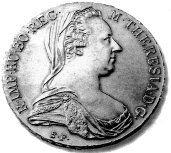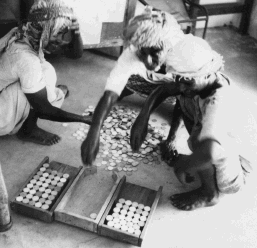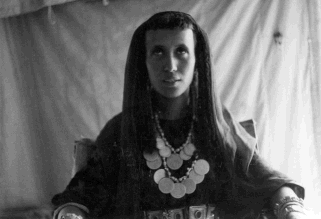Ghalib bin Awadh al-Qu'aiti
In Hadhramaut and Southern Arabia the Maria Theresa 'thaler' or 'dollar' was variously known as 'riyal', 'riyal faransah', 'faransah' and 'qarsh' (plural: 'qurush'). I will refer to it as 'riyal'. It was most probably in circulation, at least in some parts of Arabia, towards the end of the eighteenth and the early part of the nineteenth centuries.
Why did it spread and become so widely accepted? The reasons are complex. It took hold when Ottoman authority in Arabia was in decline and people increasingly regarded Ottoman currency as debased and inferior. This decline coincided with the intrusion of European powers into the Middle East, epitomised by Napoleon's invasion of Egypt and the Levant, and with the rise of Muhammad 'Ali in Egypt and the swift extension of his regional influence. These factors coupled with an increase in trade between the eastern coast of Africa and Arabia all played their part in the introduction and promotion of the Maria Theresa 'riyal' as an acceptable currency.
According to the late Shaikh Abdullah al-Nakhibi, a celebrated Hadhrami scholar and historian, with a memory spanning the reigns of five Qu'aiti sultans (1909-1967), the use of the 'riyal' was officially discontinued within Hadhramaut in favour of the Indian 'rupee' from about the time of the accession of Sultan Saleh in 1936. Shaikh Abdullah said that one of the reasons for this was its fluctuating value vis a vis the market price of silver and the 'rupee' - then the official British currency of Aden and the Protectorate (which included Hadhramaut). When the value of the 'riyal' dropped significantly the Qu'aiti government was obliged to increase the pay of its employees to cover the deficit. The British Indian rupee continued in circulation in southern Arabia until shortly after India's independence from British rule in 1947, when it was replaced by the British East African Currency Board's 'shilling' made up of a hundred 'cents'. This in turn was replaced in 1964 by the South Arabian 'dinar', which was equal to a sterling pound and made up of a thousand 'fils'.
 |
 |
| Maria Theresa Thaler. The image on the right shows a thaler counter-struck with the stamp of the Qu’aiti ruler. | |
However, in the case of the 'shilling' (pronounced locally and written in Arabic as 'shillin') and the 'dinar' later on, the terms used for the smaller denominations of the rupee continued to be applied in common usage to the various coins that made up the 'shilling' and subsequently the 'dinar', 36 MariaTheresaThaler. The image on the right shows a thaler counter-struck with the stamp of the Qu'aiti ruler. with an eye to their equivalent value. For example, during the era of the 'shilling', the ten cent coin piece was called an 'ana' and the twenty-five cent piece was referred to as a 'bau' ('pau' means a quarter in Urdu, Hindi, Gujarati, and a number of other Indian languages). Then, when the'dinar' and 'fils' were introduced, the 'dinar' was assumed to be made up of twenty 'shillings', with each fifty 'fils' piece being called a 'shillin', and the five 'fils' coin being called an 'ana'.
Nevertheless, the 'riyal' was to continue to maintain its presence locally as a source of precious metal, worth its value in weight, but also as a unit of measure (sixteen 'riyals' were equal to a 'ratl' or one pound in weight); in other parts of southern Arabia and Oman the 'riyal' remained in circulation well into the 1960s.
In Hadhramaut, the Maria Theresa 'riyal' was supposed, theoretically, to comprise one hundred 'bugshah' (plural 'bugash'): an arabicised form of 'boghcha' - a Persian term incorporated into Turkish and Urdu, which means a cloth wrapper or a small cloth pouch or purse for keeping coins. During my childhood, I remember hearing from my maternal grandmother and others how her father, Mir Mahboob Ali Khan (the sixth Nizam of Hyderabad - d. 1911), would carry with him several of these purses, each filled with small gold coins, on the howdah of his elephant in order to scatter them to the poor.
The terms applied in Hadhramaut to the various denominations of the 'rupee' were:
(1) 1 rupee = 8 'huruf' (singular: 'harf'), each 'harf' equalling 2 'annas' (Arabic: 'ana')
(2) 1/4 'rupee' was called a 'bau'; 'pau' means a quarter in several Indian languages andas there is no'p'sound inArabic, Arabs use'b'instead.
(3) 1 'anna' (Arabic: 'ana') = 4 pice or 'paysa' (Arabic: 'baysa')
(4) 1 'baysa' = 3 'ardi' = 1 'khumsiyyah' (the latter term meaning in Arabic a fifth of some specie).
Hadhrami authorities known to have struck coins include:
(1) The Sayyids (descendants of the Prophet Muhammad through his daughter Fatima and his cousin Ali) of Tarim (later to form part of the Kathiri Sultanate) in Wadi Hadhramaut had issued copper coins of the single and triple 'khumsiyyah' from as early as 1258H (1842) in support of their attempts at state building. These were struck in Singapore at the Counting Silver Riyals c. 1950. John Hewitt Collection. 38 expense of rich Hadhrami expatriates in the Far East. During the year 1270H (1853/54), they struck silver coins to the value of four, eight, sixteen and thirty 'khumsiyyah', and in 1315H (1897/98) they introduced specimens to the value of six, twelve and twenty-four, with a hundred and twenty 'khumsiyyah' making up the MariaTheresa 'riyal'.
(2) The Bin Bureik Naqibs of al-Shihr (exiled in 1866) were known to have issued a copper coin called 'diwani', the value of which was an 'ardi' (i. e. one third of a 'baysa')
(3) The Kasadi Naqib of al-Mukalla, Salah bin Muhammad (d. 1871), issued a bronze coin, the 'khumsiyyah', and a coin half its value which bear the date 1276H (1859/60).
(4) The family of the Hadhrami entrepreneur, Abdat bin Umar, who had made a fortune in Singapore and Java during the first quarter of the 20th century, issued silver coins, minted in Singapore, in denominations of four, eight, fifteen, thirty, forty-five and sixty 'khumsiyyah' (with a hundred and twenty of this last unit to the Maria Theresa 'riyal') to bolster their claims to statehood. This had followed their seizure of a small town in Wadi Hadhramaut called al-Ghurfah from the Ba Abbad clan during 1344H (1925/26), in a move to declare themselves independent of the authority of their traditional overlord, the Kathiri Sultan of Seiyun. Their claims, tenaciously pursued in later years by Ubaid bin Saleh bin Abdat, led to military confrontation with the British and Qu'aitis, acting in support of the Kathiri Sultan, and in 1364H (1945) Ubaid bin Saleh was forced into exile.
(5) In Lahej, west of Hadhramaut, the two rulers of the Abdali dynasty who issued copper coinage in the denomination of half a 'baysa' (after the Indian coin of similar value) were: Ali bin Muhsin (d. 1863) and his son Fadhl bin Ali (d. 1898).
(6) The first member of the Qu'aiti ruling family to stamp his name on specie - by counter striking - was almost certainly Abdullah bin Omar (d. 1888), who signed Treaties of Friendship (1882) and Protection (1888) with the British on behalf of himself and his brother and coruler, Awadh bin Umar (d. 1910). Upon Abdullah's death in 1888, Munassar bin Abdullah, the elder of his two sons, had proceeded to counter-strike Maria Theresa 'riyals', Indian rupees and other accepted specie in order to assert his claim as ruler. All such specimens bear the date '1307H' (1889), the year of his claimed accession, and the legend: 'al-Daulah Munassar'. The term 'al-Daulah' in Hadhramaut and other parts of southern Arabia implies 'ruler' or 'ruling house', though in classical Arabic it means the state. As Viceroy of the interior of Hadhramaut, based in Shibam and ruling ostensibly on behalf of his uncle, Awadh bin Umar, Munassar probably used a primitive contraption for counter-striking coins. However, specimens bearing his full name, 'Munassar bin Abdullah al-Qu'aiti', seem likely to have been counter-struck at a later date - despite bearing the same year '1307H' - judging from the improved standard of calligraphy. Munassar's dispute with his uncle Awadh over the succession came to a head at the turn of the century and led to his expulsion.
In the meantime, Awadh bin Umar decided to issue copper, bronze, silver and even some gold coins in his own name. According to available specimens, the years (given only in Arabic and the lunar calendar) in which these were struck are 1896/97 (1315H), 1897/98 (1316H) and 1900/01 (1318H). In addition to the name of 'Shibam', with 'al-Mukalla' and 'alShihr' on either side of it, the coins bear the Sultan's name (sometimes in the 'tughra' calligraphic style), and are in the Arabic 'naskhi' or 'thulth' script. A Hyderabadi title, awarded to Awadh bin Umar by the Nizam's court, also appears, in English, on the face of these coins: 'H. H. Sultan Nawaz jung Bahadoor'. This suggests that they may well have been struck at the Nizam's mint in Hyderabad, or otherwise in Bombay (British India), where Awadh bin Umar had large investments in real estate, and from where Aden was then administered by the British.
 |
| Counting Silver Riyals c. 1950. John Hewitt Collection. |
 |
| Beihani girl wearing a necklace of thalers c. 1950. John Hewitt Collection. |
It is interesting to note that the silver pieces issued by Awadh bin Umar were tied in terms of weight and value to the Maria Theresa 'riyal'. His coins also reveal that his offical title in usage locally was that of 'Sultan', although the British authorities in India continued to refer to the Qu'aiti ruler of Hadhramaut by his Hyderabadi military title of 'Jama'dar', until the Delhi Durbar of 1903.
Shaykh Abdullah al-Nakhibi, commenting on the customary role of the Maria Theresa 'riyal' in determining the dowry or 'mahr' payable by the groom to the bride's family, recalled that the dowry was generally fixed at five 'riyals' if the bride was of African descent, or otherwise at ten 'riyals'; cases where as much as fifteen 'riyals' might be paid were very rare. Once the terms of the marriage had been negotiated, the groom's family would normally deliver the appropriate number of 'riyals' when visiting the bride's house on the day of the'aqd'(marriage contract). As the use of gold 40 Beihanigirlwearinganecklaceofthalersc. 1950. JohnHewittCollection. was almost unknown in Hadhramaut at this period, bridal jewellery was usually fashioned out of melted down 'riyals' and, depending on the affluence of the family, would normally comprise:
1) isabah (a type of head ornament with little trinkets);
2) murriyah (a choker type of neck ornament);
3) faraj allah (a type of necklace or collar with a centre-piece or pendant that was often a 'riyal'). 'Faraj' (meaning comfort or relief from suffering) happens to be a fairly common name among males of African descent; also
4) sidar (a necklace similar to the above, extending to the level of the sadr or chest);
5) idhad (armlets worn by both women and men, often fitted with a medallion of red glass;
6) kumkumah (a type of bangle worn as a pair); also
7) kuriyyah (another type of bangle worn as a pair);
8) hizam (an ornate girdle varying in width and weight);
9) hijl (anklets).
In addition, there would be studs or rings for the ears, and rings for the hand.
Also fashioned from melted down 'riyals' were scabbards for the dagger (janbiyya) and for the single edged south Arabian sword (nimsha).
The Maria Theresa 'riyal' was bought locally by merchants and exported from various Arabian ports to India (which had a voracious appetite for silver) to be melted down. For example, the late Dhirubhai Ambani, the Gujarati entrepreneur from Aden who founded the internationally known business conglomerate, 'Reliance', exported both the MariaTheresa'riyal' and the Mutawakkilite Kingdom of Yemen's silver 'riyal' from Aden to India in the 1950s and early 1960s.
The Egyptian forces which arrived in Yemen to support the Republican regime following the 1962 coup against Imam al-Badr, were to denude that country of MariaTheresa and Mutawakkilite silver 'riyals' in order to defray the cost of their prolonged military presence. The disappearance of silver as a medium of exchange in Yemen ushered in a new era of paper currency.
Vol 18. 2010


